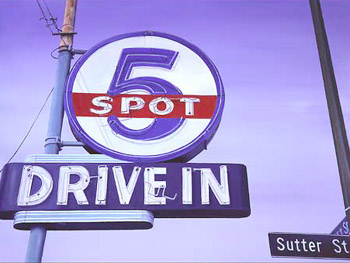![[Metroactive Arts]](/arts/gifs/art468.gif)
[ Arts Index | Silicon Valley | Metroactive Home | Archives ]
 Painting by Terry Thompson Marquee Marked: The angle of the 'Jose' sign frames the arches of the facade behind in a Terry Thompson oil on panel from 2001/2. Neon Notions Valley artist Terry Thompson details San Jose and the valley's sights and signs By Michael S. Gant ARTIST Terry Thompson and I are drinking coffee at Cafe Matisse on South First Street in downtown San Jose; by all rights, however, this interview should be taking place a few blocks away at the 5 Spot Drive In. One of Thompson's most striking paintings depicts the diner's fabled neon sign: a becircled blue numeral slashed through with a lozenge of red--"Spot"--sitting atop a rectangular support reading "Drive In." The angle of the sign's pole on the left is echoed by the street-sign stanchion on the right showing where Sutter Street intersects South First. The diner is deserted now, although the sign still stands, a beacon that has outlived its function. These days, the 5 Spot sign is on its way to becoming a purely aesthetic object, a process enhanced by Thompson's precise, evocative rendering in his oil on canvas from 2001. "I want to capture the light," says Thompson, a Mountain View native who now lives in Milpitas. It's a way of "making the not beautiful pretty." When he took up painting, in 1997, Thompson started with the traditionally "pretty." His first works treat subjects familiar to Sunday painters: a lighthouse on a rocky bluff, bougainvillea framing an adobe doorway. Soon, however, Thompson found himself intrigued by more prosaic subjects: especially the abundant examples of vernacular architecture and signage that he could see every day commuting in the Bay Area or driving to his art classes at San Jose State University: the neon lettering on the marquees of the Jose Theater downtown and the Mexico Theater on Santa Clara Street near 25th, the Fog City Diner in San Francisco. The Plaza Hotel on Almaden Boulevard won't make anyone's architectural walking tour of downtown San Jose. In his acrylic on panel from two years ago, Thompson, however, discovers a dynamic nexus of roof lines centered on the vertical stack of letters spelling "hotel"--alphabet blocks in startling red next to a muted wall of perforated concrete blocks. This structural tabula rasa contains hints of psychological drama: a lone bicyclist, the tip of a car's front bumper. Even blanker, harder to penetrate, are the flat, banded walls of San Jose Apartments, another acrylic from 2000. The planes of the two units recede to a vanishing point at the right of the frame. A horizontal thrust of juniper bush demands your attention at the forefront of the scene--the green highlights on top turning to dark shadow underneath. Thompson's paintings are scrupulously accurate in their representation of light and detail. When he was young, Thompson recalls, he made "meticulous models" from kits. "They looked just like the cover of the box." For most of his working life, Thompson, age 39, has applied that sense of meticulousness as a thin-film equipment engineer. Although he excelled at his art classes--and was a burgeoning musician--at Milpitas High School, Thompson says that he "got the feeling that I should get a real job." He has toiled in high tech for almost 20 years, long enough to note, somewhat ruefully, that "two-thirds of the companies I worked for are gone."
In the mid-'90s, Thompson began to realize that it was time for a serious life-course correction--a switch that would take him back to his original love: art. He had studied artworks and "mentally dissected them" for years, but he was spurred to undertake his new vocation when he visited the Milpitas Art and Wine Festival. An exhibit at the San José Museum of Art of works by John Register, famed for his views of empty diners and depopulated cityscapes, accelerated Thompson's decision to become a full-time artist. Thompson's learning curve proved to be startlingly steep as he experimented with acrylics, then moved to oils because they allowed him to "blend--paint one color into another." The sophistication of his technique is married to a keen eye for striking crops and framings that let the viewer "fill in the blanks." Thompson's photo-realist style calls for an unusual working method. Rather than painting from life, easel erected on the sidewalk, Thompson carries a 35 mm camera with him on his travels and takes pictures of his subjects from a multitude of angles in varying light. "It's not practical for me to be on-site. I'm not painting fast," he explains. Working from photographs gives Thompson the chance to nail down the details that the eye might miss at first glance. Thompson has expanded his fascination with representations of neon signs to assemblages incorporating neon (another technique Thompson taught himself). Sign Abstraction (2001) features a found neon Martini glass that Thompson has mounted onto the cut-out corner of an imagined sign. The sliced-off corner of two letters entice the viewer to finish the message: Live Nude Girls? Drinks? Terry Thompson has not completely realized his dream yet. That real "job" still has a hold on him for the time being. But Thompson has learned an important lesson from the transition: "Doing something you love is truly important."
Two of Terry Thompson's works are on display as part of XPO, a group show running through Aug. 31 at Cafe Matisse, 383 S. First St., San Jose. Also, check www.thompsonpaintings.com. (Disclosure: Metro owns several of Thompson's paintings.)
Send a letter to the editor about this story via email . [ Silicon Valley | Metroactive Home | Archives ]
|
From the August 22-28, 2002 issue of Metro, Silicon Valley's Weekly Newspaper.
Copyright © Metro Publishing Inc. Metroactive is affiliated with the Boulevards Network.
For more information about the San Jose/Silicon Valley area, visit sanjose.com.
